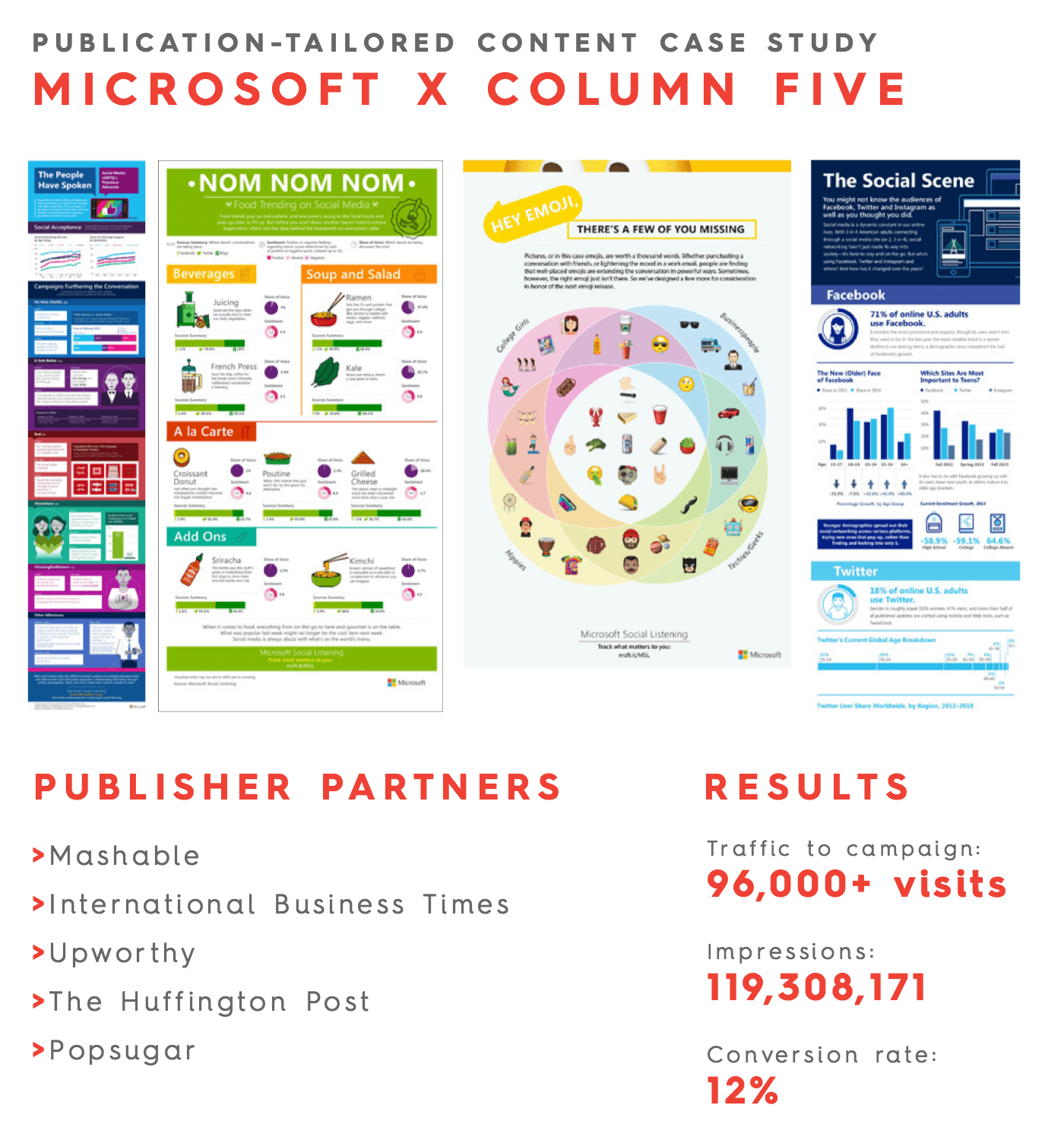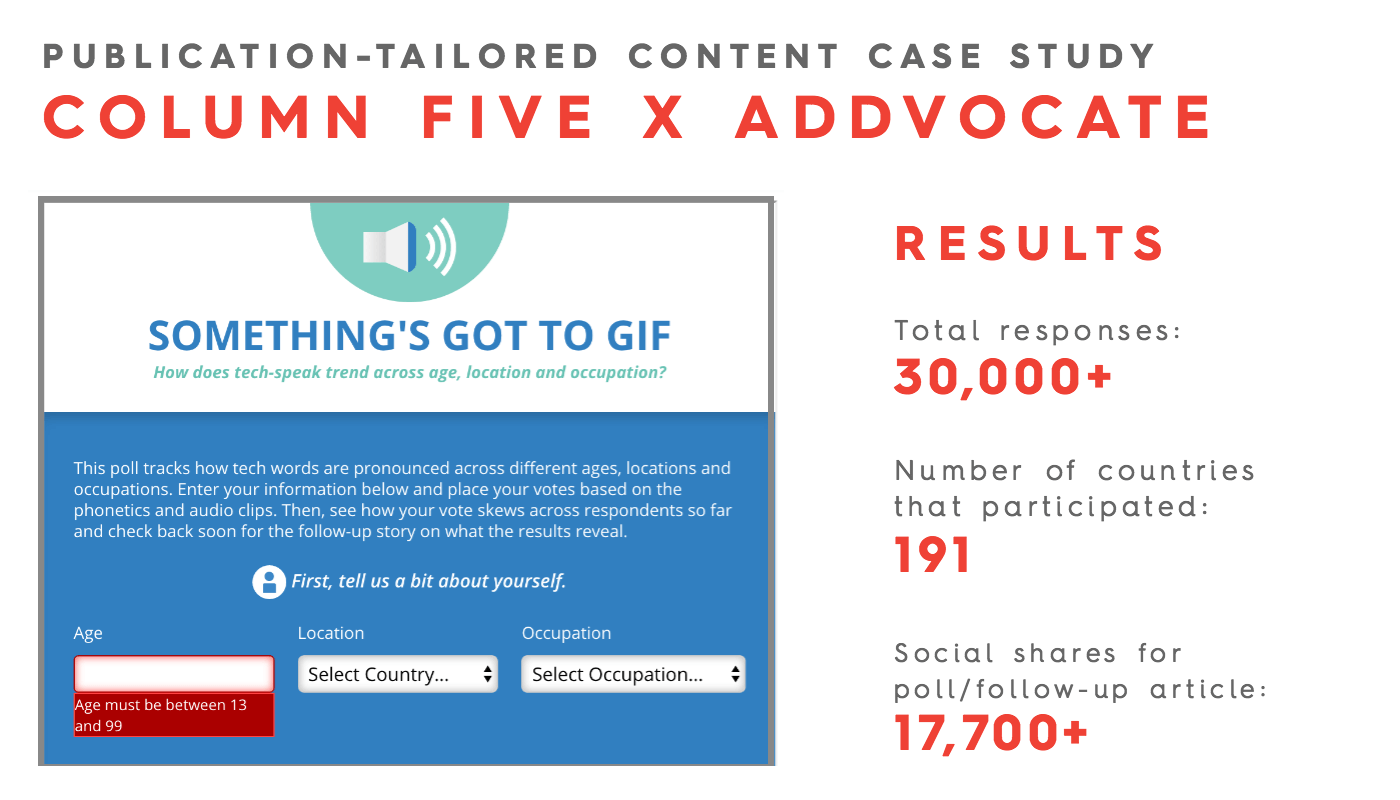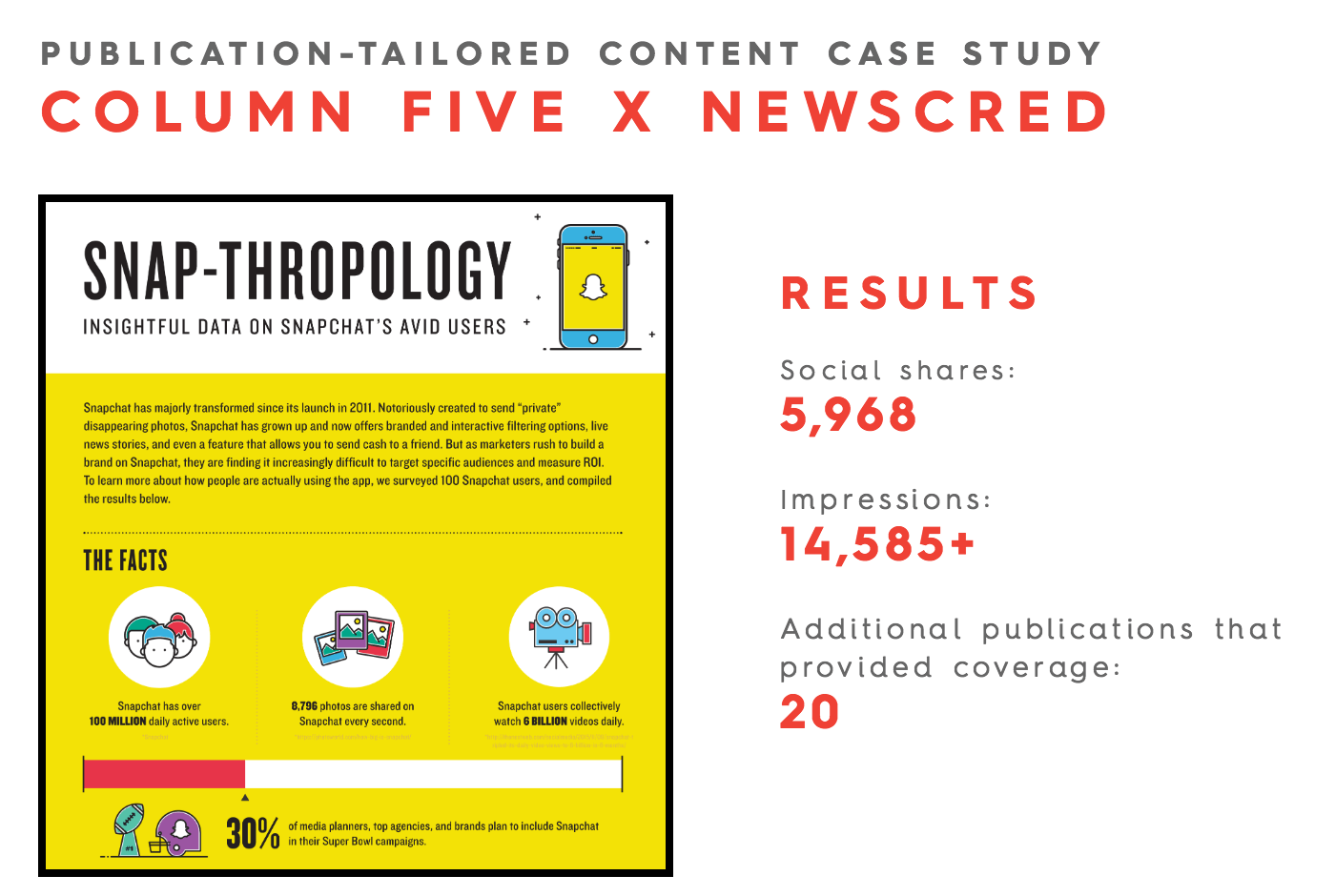Your earned media strategy is an important part of your content’s success. But if you’ve struggled to get placement in major publications, it might be because the traditional approach to PR is, well, a little stale. To increase your chances of earned media success, you need to collaborate with publishers—not throw content at them.
After much trial and error, we’ve found that a Publication-Tailored Content (PTC) strategy is the best approach. It’s a unique tactic that flips the old-school PR paradigm: Instead of cold-pitching publishers, you bring them into the creative process. This enables you to create content they love, while getting the coverage you want.
If your earned media strategy isn’t working as well as you’d like, Publication-Tailored Content might change the game.
Why Your Earned Media Strategy Doesn’t Work
The digital distribution landscape is almost unrecognizable since we first started back in 2008.
At that time, our cofounder Jason Lankow was one of the top 5 Digg influencers in the world. Infographics were exploding, sending unbelievable traffic to sites (so much so that clients’ sites would sometimes crash), and publishers were thirsty for visual content. In Internet years, it feels like a hundred years ago. And it might as well be.
Earned media is still an incredibly valuable channel. (According to Nielsen, 92% of people worldwide trust earned media.) But getting publishers to feature your content has become increasingly difficult for many reasons.
- Oversaturation: Journalists are overwhelmed by the sheer volume of pitches they receive. According to a 2014 Harvard Business Review survey, 40% of journalists receive a minimum of 20 pitches a day, and some receive up to 100. To be considered, your content has to impress.
- Weak pitches: The days of the page-long press release are gone, yet many PR pros still send out long, boring pitches. And let’s not talk about faxed pitches—yes, they still happen.
- Bad content: Bad content is everywhere. It usually includes little useful information, 3 logos, and about 14 brand mentions. But even good content can still be a bad fit for an editor’s beat if it’s too stale, overdone, or irrelevant.
- Disconnected process: In many content marketing operations, the content process is siloed. A creative team creates something they like and sends completed content to a PR team, who then catapults the content across the Web to the publications they want to be featured in. It’s a total crapshoot and, unsurprisingly, publishers often reject that content.
Many of these issues stem from the same root problem: a brand-centric approach, as opposed to an editorial approach. This is a common flaw in earned media strategy, both in content creation and distribution.
To increase your chances of placement, you need to ensure your brand is focused on two key areas:
1) Audience-centric content
When it comes to content creation, brands tend to focus on their own goals (e.g., getting featured in publications that will make them look good). But if you want to make content publishers love, you need to focus on what their audiences want. An “audience first” mentality will also influence the publications you target in your earned media strategy.
Getting published in Time might get you prestige, but an industry publication will get you the audience most likely to convert.
2) Collaborative relationships
Editors and journalists do want content—so long as it engages their audience (and, by default, makes them look good, too). If you’re looking to create audience-centric content for a publication, you need to know what subjects and ideas resonate with them.
Editors and journalists are the gatekeepers of this information. Nurturing relationships with these individuals eliminates the guessing game.
So, how do you revamp your earned media strategy to focus on these areas? Through Publication-Tailored Content.
What Is Publication-Tailored Content?
It’s basically the reverse approach to traditional earned media strategy. Instead of pitching your content to publishers post-completion, it’s bringing publishers into content development, ensuring you’re appealing to their audience from the start. The result is, as the name suggests, a piece of content tailored for a specific publication and audience.
PTC is a true collaboration between your brand and your publishing partner, from ideation to creation.
- Ideas are vetted by your publishing partner. (They may have ideas to share as well.)
- Content is designed for the publication’s aesthetic and/or preferences.
- Your publisher provides feedback on content iterations.
- Content is typically co-branded.
This earned media strategy is significantly more effective because it benefits all stakeholders: brands, publishers, and the audience that consumes it.
Brand benefits
- Better ROI: This approach greatly increases the likelihood of getting published, meaning your time and energy aren’t wasted on a piece of content that doesn’t get results.
- Larger reach: With placed content, you tap into larger audiences (more importantly, targeted audiences that are more likely to be interested in your product or service).
-
Higher SEO/traffic: Links from sites with strong domain authority will help your SEO, bringing you more traffic that converts. (A 2014 study by Conductor & Demand Metric found that organic search leads converted 15% more than paid search leads.)
-
Credibility: Appearing in major publications makes your brand more legitimate. Audiences will come to trust your expertise.
- Continued collaboration: Because you’re providing valuable content, publishers will see you as a reliable content source. (After we implemented a Publication-Tailored Content strategy, publications began proactively asking us for content to help support their stories.)
Case study: We partnered with Microsoft Social Listening to create a Publication-Tailored Content series for the brand’s social listening tool. We worked with publishing partners to find out which newsworthy, shareable topics might appeal to their audiences and created custom content for each.
These placements, coupled with paid amplification, helped Microsoft meet and exceed its goal of media coverage, traffic, conversions, and brand visibility.

Publisher benefits
- Free content: You’re providing them with high-quality content they don’t have to pay for or bother their already-swamped teams to create.
- Relevant content: Publishers don’t hate pitches (according to HBR, 70% of journalists want pitches related to their beat), they just hate pitches they can’t use. With Publication-Tailored Content, they get to be a part of the process and provide their input before content is created.
- Diversity: Publishers are often strapped for resources. Giving them varied formats of high-quality content (interactives, infographics, video, etc.) helps them provide a better storytelling experience to their audience.
- Exclusivity: Publication-Tailored Content is custom content, created just for them. This gives publishers a competitive advantage.
Case study: We partnered with Addvocate on a PTC project for Mashable: an interactive poll to find out how the site’s readers pronounce tech terms. This gave Mashable an opportunity to engage their audience, experiment with an exciting new format, and generate proprietary data.

Audience benefits
- Engaging storytelling: Whether it’s an interesting data visualization or shorter-form visual content supporting a larger article, PTC provides an extra layer of storytelling.
- Brand expertise: Your brand knows the ins and outs of the subject matters you’re covering. This specialized knowledge gives audiences authoritative information they might not get elsewhere.
- Brand discovery: Audiences want to engage with brands they believe in through storytelling—not selling. If your story is engaging, emotional, or enlightening, they’re more interested in your content. (Mattress company Casper has gone so far as to hire journalists to create content for its sleep-centric publication Van Winkle’s.)
Example: We partnered with Newscred to create a PTC infographic to educate fellow marketers about Snapchat users. The content provided their audience useful information. It was also picked up by many other marketing publications, giving us additional exposure.

How to Put PTC Into Practice
Over the last few years, we have tested and refined the PTC process to make it as simple—and effective—as possible. What we’ve outlined here assumes you have established relationships with your publishing partners.
If you need info on identifying your target publications, getting contact info, and establishing relationships, check out this post.
1) Invite publishers into creation process
PTC relies on willing collaboration from all parties. To do this, all stakeholders need to be involved from the beginning.
We usually start the process with a cursory exploratory phase to start exploring ideas. That sometimes means we schedule a kick-off call or email a publisher to find out what type of content they might be open to.
PTC is not about approaching a publisher and demanding they work with you. It’s about offering your services to provide more value to their audience.
Tip: Editorial interns may be a great place to start if you don’t have the strongest relationship with a publication. They’re not so overwhelmed with pitches, and they’re eager to bring new and cool ideas to editors.
Some good questions to ask at this stage:
- What topics do your audiences respond to most?
- Are there any upcoming stories that might benefit from supporting content?
- What formats are you interested in (e.g., infographics, interactive content, videos, etc.)?
- What do you wish you could explore but don’t have time for?

The goal is to come up with an attractive idea. Some types of brand content are particularly attractive to publishers, specifically:
- Research or studies
- Proprietary data
- Industry expertise or insights

Sometimes publishers will have specific content requests or ideas. Other times they’ll give you full freedom to come up with an idea. (Some of our favorite early Publication-Tailored Content pieces came from publishers who encouraged us to get weird and really experiment.)
Above all, it’s important to root your ideation around the publication’s audience, ensuring it fits well with the tone of content they already produce.
Once you have your idea, circle back to share it with your publisher contact and get their feedback. Before you start producing the content, you will also want to address any specific details as it pertains to:
- Content: Medium, story, length, etc.
- Design: Dimensions, file format, branding colors or visual language
- Promotion: Timeline, publish date, exclusives, etc.
Once you have the greenlight, you can move into content creation.
2) Create the content
Depending on your publishing partner, they may want to be very involved in content creation (e.g., helping build outlines or providing sources) or they may leave it to you. Ask them which parts of the process they’d like to chime in on before you dive in.
Even if they’re happy to leave you to your own devices, it is important to maintain communication and get buy-in and feedback on content at the appropriate stages, whether that’s outlines, wireframes, or design iterations.
But before you send your content, do your best to make sure it’s up to par.
- Content: Is the story there? Does it match the publication’s tone and voice? Is there any information missing? Has it gone through a thorough copy and fact check?
- Design: Is it on-brand and appropriate for the subject? Are there any aesthetic preferences to keep in mind? (For example, due to editorial brand standards, a publication may avoid any graphics that use the color purple.)
Something to keep in mind: If you are just starting out with PTC, be amenable to any requested changes. You want to position your brand as a useful resource.
3) Nurture Your Relationships with Publishers
Ideally, you will prove your value to your publishing partner and find more opportunities to work together in the near future. Until then, here are some things that can help you lay the groundwork for those collaborations:
- Stay up-to-date on the types of stories and formats the publications you care about are utilizing.
- Follow content trends to keep your ideas fresh and your formats aligned with your objectives and audiences.
- Ask your publishing partners how the content you’re producing together is performing. How is their audience reacting? What about their co-workers?
- Continue to build a real human relationship with your publishing partners. They’re probably fun to talk to about non work-related topics too.
Something to Keep in Mind
While this is an effective tactic, there are some things that can affect its success. Consider these issues before you pursue PTC.
Some publishers may not be interested in collaborating. This is more atypical, but some publications may have restrictions in place, depending on the maturity of their native advertising practice.
It takes time. Forging relationships, brainstorming the right ideas, wrangling multiple stakeholders, creating content, getting feedback, and managing edits can take a lot of time. If you are working within a dedicated timeframe, make sure to account for these stages.
It requires resources. There is nothing worse than over-promising and under-delivering on a project. That’s the quickest way to damage your relationships with publishers. During the ideation phase, make sure that you can produce what you are pitching.
It might not get published. Your contact might leave the publication before the project is completed. Or they may decide to switch directions entirely—even after they’ve approved an idea. While this can be disappointing, it doesn’t mean your content is dead in the water. If it appeals to one publication, it will likely appeal to another.
Earned media, like all other aspects of the Internet, is an ever-changing landscape. What worked or was valuable to publications a month ago may become obsolete as media companies continue to innovate the way they report and tell stories.
The best thing you can do is continue to build sincere relationships and maintain an open dialogue. You never know where inspiration will come from.
If you need a little help reaching the right audience, we’re always happy to chat. And if you want more tips on content creation and distribution, download our free e-book, The Ultimate Guide to Content Distribution, try these 16 ways to think of amazing infographic ideas, and avoid these 8 design mistakes in your visual content.




